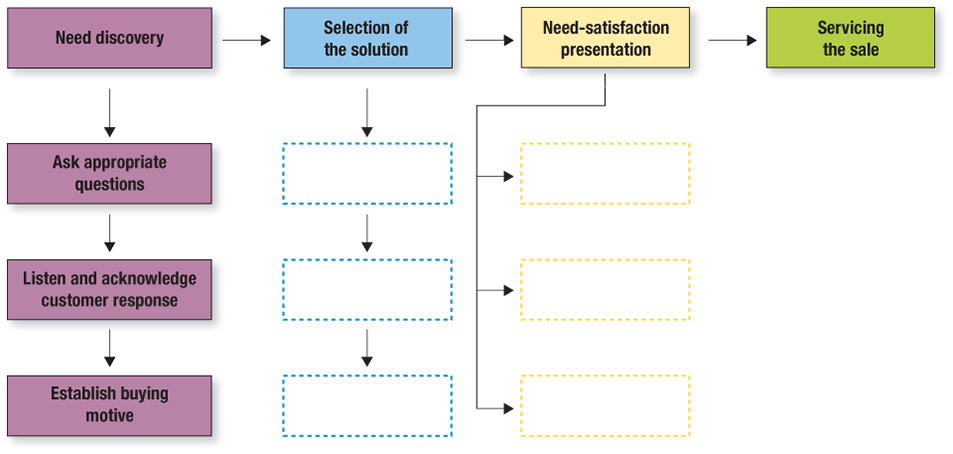Creating Value with Need Discovery
11.3 Discuss the use of questions to discover customer needs
A lawyer does not give the client advice until the legal problem has been carefully studied and confirmed. A doctor does not prescribe medication until the patient’s symptoms have been identified. In like manner, the salesperson should not recommend the purchase of a product without thorough need identification. You start with the assumption that the client’s problem is not known. The only way to determine and confirm the problem is to get the other person talking. Effective relationship builders are willing to listen to better understand customer challenges. They ask questions that lead to consultative conversations, which open doors to greater opportunities.10 You must obtain information to properly clarify the need, propose a single solution, or offer a range of solutions.
Customers may not realize that they actually have a problem. Even when they are aware of their need, as noted earlier by Salesforce.com’s Dave Levitt, given the wide range of solutions and new products available today, they may not realize that an actual solution to their problem exists. Bringing new insights regarding both their buying problem and enhanced solutions creates value for your customer.
Need discovery (sometimes called “need analysis” or “needs assessment”) begins with precall preparation when the salesperson is acquiring background information on the prospect. As noted in Chapter 9, this part of need discovery is also referred to as “qualifying the prospect.” Need discovery, and in some cases the qualification process, continues once the salesperson and the customer are engaged in a real dialogue. Through the process of need discovery, the salesperson establishes two-way communication by asking appropriate questions and listening carefully to the customer’s responses. These responses usually provide clues concerning the customer’s dominant buying motives (Figure 11.3).

Figure 11.3 Three Dimensions of Need Discovery
Need Discovery—Asking Questions
The effective use of questions to achieve need identification and need satisfaction is one of the greatest challenges facing most professional salespeople. The types of questions you ask, the timing of those questions, and how you pose them greatly impact your ability to create customer value. In many situations, asking high–value-added questions that enlighten your prospect both about their needs and possible solutions results in an immediate sale.
The strategic approach to asking questions has been the focus of two major studies. These studies were conducted in response to the emergence of the marketing concept and evolution of the consultative and strategic selling eras discussed in Chapter 2. Neil Rackham conducted this research for his book SPIN Selling and SPIN Selling Sales Training programs, and Xerox Learning Systems for their successful Personal Selling Skills (PSS) course.
The Spin Selling Model
According to research conducted during the strategic selling era (see Chapter 2, Table 2.1 Evolution of Personal Selling) on more than 35,000 salespeople by Neil Rackham, mastering the use of questions can increase one’s success in sales by 17 percent.11 Questions help clarify the exact dimensions of the problem, help the customer evaluate a range of solutions, and assist the customer in evaluating the potential outcome of the solution that is implemented.12 Rackham’s research focused on strategies for making large-ticket sales and is based on a close examination of successful salespeople. Rackham found the investigative or need-discovery stage of the sales process has the most impact on the buyer’s decision to purchase a product. He recommends a multiple-question approach that involves using four types of questions in a specific sequence (see Selling in Action on p. 234). Spin sales training programs are presented by the Miller Heiman Group (www.millerheimangroup.com/sales-ready/).
Personal Selling Skills Model
The importance of questioning to establish two-way communication was revealed in another study conducted during the consultative selling era. Research conducted by Xerox Learning Systems was used to develop the original Xerox Personal Selling Skills training program. Sales personnel were interviewed to identify the characteristics of a successful sales call. The results were quite surprising. A successful sales call lasts an average of 30 minutes. During this period, the salesperson asks an average of 13.6 questions, discusses an average of 7.7 product features, and describes approximately six product benefits. During the successful sales call, the customer asks approximately eight questions.13 This 18-month study of behavioral differences among high-, average-, and low-performance salespeople illustrates that a successful sales call is a model of good two-way communication. Regarding the specific use of questions, the results revealed high performers do the following:
Use effective questions to gather information and build a clear, complete, mutual understanding of customer needs.
Guide the direction of a sales call by striking an appropriate balance between open and closed questions.
Use their questioning strategy to facilitate an open exchange of information.14
This study has been used to create and update the very successful Personal Selling Skills training program, now also presented by Miller Heiman Group (www.millerheimangroup.com/achieveglobal/).
Socratic Selling Model
The art and science of using questions was also discussed by Socrates more than 2,500 years ago. He noted, among other things, that questions tend to make people think. It’s nearly impossible to remain passive when confronted with a direct question. Today, there are sales training programs such as Michael Hargrove’s “Using the Socratic Selling Methods” and books such as Kevin Daley’s Socratic Selling: How to Ask the Questions That Get the Sale that include many of the observations of Socrates.15
In every selling situation, you want the prospect to be actively thinking, sharing thoughts, and asking questions. Appropriate questions reduce tension and build trust in a selling situation because they communicate interest in the other person’s welfare. Until the person begins to talk freely, the salesperson will have difficulty diagnosing and solving the customer’s problems.
